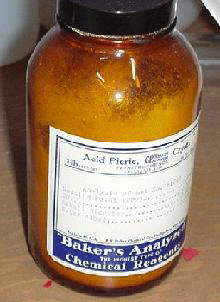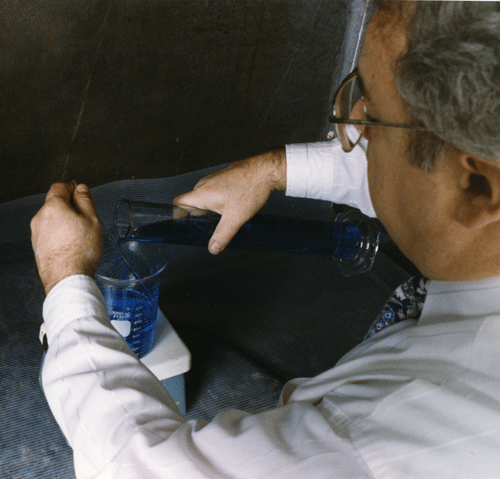Picric acid (2,4,6-trinitrophenol, [(NO2)3C6H2OH]) is widely used in metallography labs for the common steel etchants known as picral, a 4% solution in ethanol, Vilella’s reagent, 1 g picric acid and 5 mL HCl and 100 mL ethanol, and alkaline sodium picrate (2 g picric acid, 20 g NaOH, 100 mL water) for coloring M3C and M6C carbides, as well as several other formulations.
Picric acid was formulated by Peter Woulfe, a British chemist, in 1771, although Glauber is claimed to have written about it in 1742. The name comes from the Greek word pikros which means bitter, as picric acid has a bitter taste (it is toxic). Initially it was used to dye fabrics yellow. In the early 20th century, workers producing picric acid were sometimes called canaries, because their skin also became stained yellow.
Introduction
 The explosive nature of picric acid was discovered in 1885 in England which led to the 1888 development of an explosive called Lyddite, named after the location of the studies, Lydd, England. Another source states that the explosive nature of picric acid was first known in 1830, and it was proved to detonate in 1873. In 1894, Russian scientists manufactured artillery shells using picric acid salts and picric acid-based explosives were used in WWI. Anhydrous picric acid is related to TNT, a much more potent explosive. When concentrated, it will attack metals producing shock-sensitive salts that are explosive. This was discovered in 1916 at a French ammunition factory when a fire caused molten picric acid to wet a concrete floor, forming calcium picrate which detonated killing 170 people.
The explosive nature of picric acid was discovered in 1885 in England which led to the 1888 development of an explosive called Lyddite, named after the location of the studies, Lydd, England. Another source states that the explosive nature of picric acid was first known in 1830, and it was proved to detonate in 1873. In 1894, Russian scientists manufactured artillery shells using picric acid salts and picric acid-based explosives were used in WWI. Anhydrous picric acid is related to TNT, a much more potent explosive. When concentrated, it will attack metals producing shock-sensitive salts that are explosive. This was discovered in 1916 at a French ammunition factory when a fire caused molten picric acid to wet a concrete floor, forming calcium picrate which detonated killing 170 people.
Fortunately, there have been no documented cases of explosions from picric acid in laboratories, according to Phifer [1]. If it is wet with water, it is not an explosive hazard and any attempt to blow it up by a bomb squad will only result in picric acid being spread all over the immediate area. The concern has always been in finding an old bottle that has dried up producing dehydrated picric acid, and if it has a metal cap, rather than a plastic cap. In such a case, shock-sensitive metallic picrates may have formed at the cap-bottle interface. The solution is to have a robot pick it up and re-hydrate the picric acid after opening the bottle under water. If the cap is plastic, and the acid has dried out, friction from opening the cap could cause detonation. The solution here is to place the bottle in a large bucket or tank of water and allow water to dissolve any dried picric acid on the cap threads. Leave the bottle in the water for a few days until some water can be seen inside the bottle. Then, while under water, open the lid and re-hydrate the picric acid.
I have used 4% picral, superpicral, Vilella’s reagent, a 10:1 mix of 4% picral and 2% nital, alkaline sodium picrate at just below the boiling point, and several variants of aqueous saturated picric acid with or without minor amounts of HCl and with various wetting agents at either room temperature or just below the boiling point. These reagents are really excellent and indispensable in the lab. When using these reagents, I always use tongs to hold my specimen and if I am swabbing, the cotton is held with tongs. Nevertheless, no matter how careful I am, I get yellow picric acid stains on my fingers (but hopefully not on my clothes!). This seems to be a bigger problem with etchants containing picric acid than with any other known reagent. It seems to have unnatural wetting powers! Fortunately, the yellow stains do not seem to be serious medical problem. Picral is far better than nital for revealing carbides and constituents such as bainite and pearlite. It will not darken as-quenched martensite, which is helpful at times. Superpicral has occasionally revealed prior-austenite grain boundaries in some difficult alloys such as solution annealed and aged PH stainless steels. Vilella’s is very useful with higher alloy steels such as tool steels. The 10:1 mix is excellent for examining nitrided cases. Alkaline sodium picrate is great for preferentially coloring cementite (it also colors M6C carbide). The most successful etchants for revealing prior-austenite grain boundaries in heat treated steels are saturated aqueous picric acid solutions containing a wetting agent and perhaps a very small HCl addition. These etchants are essential in metallography and preventing the use of picric acid, which is the case in some localities, is highly detrimental. The only solution is for metallographers, and others who use picric acid, to use it carefully while employing safe laboratory practices. Unfortunately, very few schools teach laboratory safety aside from the simplest aspects. Learning “the hard way” is to be avoided!
 The wise lab manager checks the picric acid bottle periodically (which can vary with lab usage of picric in etchants) to make sure that the picric acid remains wet. Today, bottles are sold with at least 30% water content. When you buy a new bottle, date it but do not open it until you need to, then date the first use. A good practice is to keep a log of when the bottle has been checked and when water is added. Also, to be safe, use only plastic or glass spatulas to remove picric from the bottle and add it to the etchant. Do not use metal spatulas and clean the cap and threads on the bottle and on the cap with a wet paper towel before closing the bottle. Buy only as much picric acid as you expect to use within a few years – avoid the 30 year old dried out bottle in the closet problem! If you have copper piping, do not dispose of picric acid by pouring it down the drain as explosive metallic salts could form.
The wise lab manager checks the picric acid bottle periodically (which can vary with lab usage of picric in etchants) to make sure that the picric acid remains wet. Today, bottles are sold with at least 30% water content. When you buy a new bottle, date it but do not open it until you need to, then date the first use. A good practice is to keep a log of when the bottle has been checked and when water is added. Also, to be safe, use only plastic or glass spatulas to remove picric from the bottle and add it to the etchant. Do not use metal spatulas and clean the cap and threads on the bottle and on the cap with a wet paper towel before closing the bottle. Buy only as much picric acid as you expect to use within a few years – avoid the 30 year old dried out bottle in the closet problem! If you have copper piping, do not dispose of picric acid by pouring it down the drain as explosive metallic salts could form.
Virtually all chemicals and solvents used in the laboratory are dangerous; hence we must develop good safe laboratory practices and teach our employees what to do to avoid problems. Picric acid is toxic. Personally, I have never heard of a problem in a metallography/materialography laboratory from picric acid – but, I know of four accidents from nital (2-3% nitric acid in ethanol; one accident used isopropyl alcohol instead), which people consider to be very safe to use. Every dangerous chemical or solvent cannot be outlawed for use, or we will not be able to work. Even water can be considered as being dangerous, because every year many people drown, but we would never consider outlawing water. The solution is to establish a good laboratory safety program and train employees and develop safe working habits. Vander Voort [2-4] has summarized lab safety aspects as a sequel to the superb treatise by Anderson [5]. ASTM E 2014 lists a number of books on laboratory safety and is a good source of information on metallography lab safety.
George Vander Voort has a background in physical, process and mechanical metallurgy and has been performing metallographic studies for 43 years. He is a long-time member of ASTM Committee E-4 on metallography and has published extensively in metallography and failure analysis. He regularly teaches MEI courses for ASM International and is now doing webinars. He is a consultant for Struers Inc. and will be teaching courses soon for them. He can be reached at 1-847-623-7648, EMAIL: georgevandervoort (AT) yahoo (DOT) com and through his web site: www.georgevandervoort.com
To View a listing of all George’s articles please click here
Read George Vander Voort’s Biography
